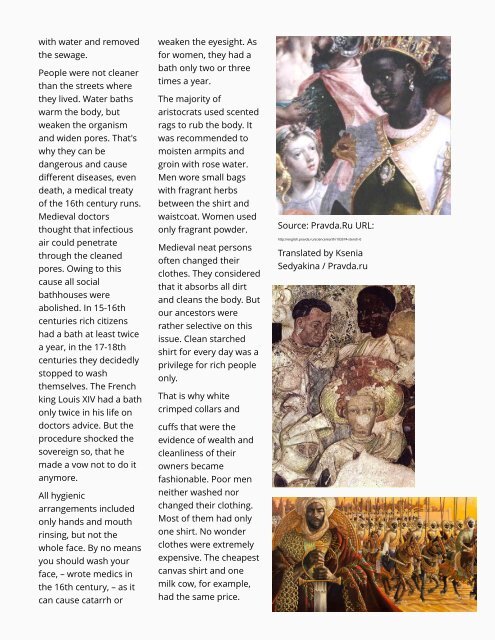You also want an ePaper? Increase the reach of your titles
YUMPU automatically turns print PDFs into web optimized ePapers that Google loves.
with water and removed<br />
the sewage.<br />
People were not cleaner<br />
than the streets where<br />
they lived. Water baths<br />
warm the body, but<br />
weaken the organism<br />
and widen pores. That's<br />
why they can be<br />
dangerous and cause<br />
different diseases, even<br />
death, a medical treaty<br />
of the 16th century runs.<br />
Medieval doctors<br />
thought that infectious<br />
air could penetrate<br />
through the cleaned<br />
pores. Owing to this<br />
cause all social<br />
bathhouses were<br />
abolished. In 15-16th<br />
centuries rich citizens<br />
had a bath at least twice<br />
a year, in the 17-18th<br />
centuries they decidedly<br />
stopped to wash<br />
themselves. The French<br />
king Louis XIV had a bath<br />
only twice in his life on<br />
doctors advice. But the<br />
procedure shocked the<br />
sovereign so, that he<br />
made a vow not to do it<br />
anymore.<br />
All hygienic<br />
arrangements included<br />
only hands and mouth<br />
rinsing, but not the<br />
whole face. By no means<br />
you should wash your<br />
face, ? wrote medics in<br />
the 16th century, ? as it<br />
can cause catarrh or<br />
weaken the eyesight. As<br />
for women, they had a<br />
bath only two or three<br />
times a year.<br />
The majority of<br />
aristocrats used scented<br />
rags to rub the body. It<br />
was recommended to<br />
moisten armpits and<br />
groin with rose water.<br />
Men wore small bags<br />
with fragrant herbs<br />
between the shirt and<br />
waistcoat. Women used<br />
only fragrant powder.<br />
Medieval neat persons<br />
often changed their<br />
clothes. They considered<br />
that it absorbs all dirt<br />
and cleans the body. But<br />
our ancestors were<br />
rather selective on this<br />
issue. Clean starched<br />
shirt for every day was a<br />
privilege for rich people<br />
only.<br />
That is why white<br />
crimped collars and<br />
cuffs that were the<br />
evidence of wealth and<br />
cleanliness of their<br />
owners became<br />
fashionable. Poor men<br />
neither washed nor<br />
changed their clothing.<br />
Most of them had only<br />
one shirt. No wonder<br />
clothes were extremely<br />
expensive. The cheapest<br />
canvas shirt and one<br />
milk cow, for example,<br />
had the same price.<br />
Source: Pravda.Ru URL:<br />
http://english.pravda.ru/science/earth/103574-stench-0<br />
Translated by Ksenia<br />
Sedyakina / Pravda.ru





